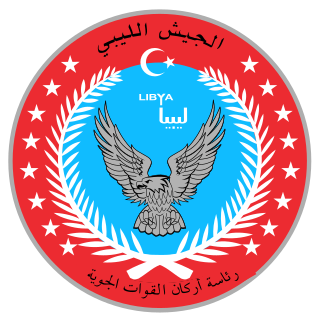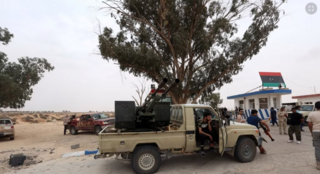
The Libyan Air Force is the branch of the Libyan Armed Forces responsible for aerial warfare. In 2010, before the Libyan Civil War, the Libyan Air Force personnel strength was estimated at 18,000, with an inventory of 374 combat-capable aircraft operating from 13 military airbases in Libya. Since the 2011 civil war and the ongoing conflict, multiple factions fighting in Libya are in possession of military aircraft. As of 2019 the Libyan Air Force is nominally under the control of the internationally recognised Government of National Accord in Tripoli, though the rival Libyan National Army of Marshal Khalifa Haftar also has a significant air force. In 2021, the air force is under command of the new President of Libya, Mohamed al-Menfi that replaced Fayez al-Sarraj.

Field Marshal Khalifa Belqasim Omar Haftar is a Libyan politician, military officer, and the commander of the Tobruk-based Libyan National Army (LNA). On 2 March 2015, he was appointed commander of the armed forces loyal to the elected legislative body, the Libyan House of Representatives.

The Libyan National Army or the Libyan Arab Army is a component of Libya's military forces which were nominally a unified national force under the command of Field Marshal Khalifa Haftar when he was nominated to the role on 2 March 2015 by the House of Representatives, consisting at the time of a ground force, an air force and a navy.

The Libyan civil war (2014–2020), also more commonly known as the Second Libyan Civil War, was a multilateral civil war which was fought in Libya between a number of armed groups, but mainly the House of Representatives (HoR) and the Government of National Accord, for six years from 2014 to 2020.

The Shura Council of Benghazi Revolutionaries was a military coalition in Benghazi composed of Islamist and jihadist militias, including Ansar al-Sharia, Libya Shield 1, and several other groups.

The Libyan Crisis is the current humanitarian crisis and political-military instability occurring in Libya, beginning with the Arab Spring protests of 2011, which led to two civil wars, foreign military intervention, and the ousting and death of Muammar Gaddafi. The first civil war's aftermath and proliferation of armed groups led to violence and instability across the country, which erupted into renewed civil war in 2014. The second war lasted until October 23, 2020, when all parties agreed to a permanent ceasefire and negotiations.
al-Watiya Air Base also known as Okba Ibn Nafa Air Base is a military airport in the Nuqat al Khams district of western Libya. It was named after Uqba ibn Nafi, the Islamic general who conquered North Africa. It is 27 kilometres (17 mi) east of the Tunisian border and 125 kilometres (78 mi) from Tripoli.

The Government of National Accord was an interim government for Libya that was formed under the terms of the Libyan Political Agreement, a United Nations–led initiative, signed on 17 December 2015. The agreement was unanimously endorsed by the United Nations Security Council, which welcomed the formation of a Presidency Council for Libya and recognized the Government of National Accord as the sole legitimate executive authority in Libya. On 31 December 2015, Chairman of the Libyan House of Representatives, Aguila Saleh Issa declared his support for the Libyan Political Agreement. The General National Congress has criticized the GNA on multiple fronts as biased in favor of its rival parliament the House of Representatives.
This is a detailed timeline of the Libyan civil war (2014–2020) which lasted from 2014 to 2020.

The Western Libya campaign was a military campaign initiated on 4 April 2019 by the Operation Flood of Dignity of the Libyan National Army, which represents the Libyan House of Representatives, to capture the western region of Libya and eventually the capital Tripoli held by the United Nations Security Council-recognised Government of National Accord. The Government of National Accord regained control over all of Tripoli in June 2020 and the LNA forces withdrew from the capital, after fourteen months of fighting.
On 2 July 2019 at 23:30, during the 2019–20 Western Libya campaign, an airstrike hit the Tajoura Detention Center outside Tripoli, Libya, while hundreds of people were inside the facility. The detention center was being used as a holding facility for migrants and refugees trying to reach Europe when a storage hangar that it used as a residential facility was destroyed in an aerial bombing. The United Nations Human Rights Council stated that "It was known that there were 600 people living inside" the facility.

In 2020, Turkey militarily intervened in support of the United Nations-recognized Government of National Accord (GNA) of Libya in the 2014–2020 Libyan civil war. Military intervention was approved by the Grand National Assembly of Turkey on 2 January 2020, which passed a one-year mandate to deploy troops to Libya. Turkish military deployments to Libya began on 5 January.
This is the order of battle for the Western Libya campaign, codenamed "Operation Flood of Dignity" by forces under Field Marshal Khalifa Haftar. The forces supporting Haftar and the House of Representatives, mainly the Libyan National Army, are opposed by the armed forces of the forces loyal to the Government of National Accord, including the Libyan Army and the Tripoli Protection Force.

The Chengdu GJ-2, also known as Wing Loong 2, is an unmanned aerial vehicle (UAV) capable of remotely controlled or autonomous flight developed by the Chengdu Aircraft Industry Group in the People's Republic of China. Intended for use as a surveillance and aerial reconnaissance and precision strike platform, Chengdu unveiled the concept of Wing Loong II at the Aviation Expo China in Beijing in September 2015. Wing Loong II has long range strike capability with a satellite link.

The Central Libya offensive, officially known as Operation Paths to Victory, was a military offensive in Libya launched by the forces of the Government of National Accord, to take the city of Sirte and Al Jufra Airbase from the House of Representatives backed by the Libyan National Army. The city of Sirte is considered strategically important because of its close position to oil facilities, which give it control over Libya's oil and gas shipping ports. The Al Jufra Airbase is strategically important for the GNA, due to its central position to Fezzan and denying the Libyan National Army air superiority over Central Libya.

The Egyptian intervention in Libya has been substantial since the beginning of the civil war. The intervention started after the Islamic State of Iraq and the Levant (ISIL) released a video of the beheading of 21 Egyptians on February 12th, 2015. In response, Egypt launched airstrikes on the 16th of February that same year. After that incident, Egypt became increasingly involved with Libya's internal politics.
The Wagner Group, also known as PMC Wagner, a Russian paramilitary organization also described as a private military company (PMC), a network of mercenaries, and a de facto unit of the Russian Ministry of Defence (MoD) or Russia's military intelligence agency, the GRU, has conducted operations in Libya since late 2018.

Operation Volcano of Anger, alternatively known as Operation Volcano of Rage, was a military resistance campaign launched by the Government of National Accord in Libya to counter the advances of the Libyan National Army led by General Khalifa Haftar. The conflict, which began in April 2019, has witnessed intense fighting around the capital city, Tripoli, and other strategic locations in the country. The operation is part of the broader armed conflict in Libya, marked by shifting alliances, foreign involvement, and a struggle for control over the nation's political future.
The Battle of Gharyan, which unfolded from April 2019 to June 2019, was a significant conflict in the ongoing struggle for control in Libya. The opposing forces were the Libyan National Army (LNA), led by General Khalifa Haftar, and the Government of National Accord (GNA), headed by Prime Minister Fayez al-Sarraj.

The Battle of Al-Watiya Airbase in 2020 marked a crucial turning point in the Second Libyan Civil War, as Government of National Accord (GNA) forces sought to reclaim control from the Libyan National Army (LNA) led by General Khalifa Haftar.











